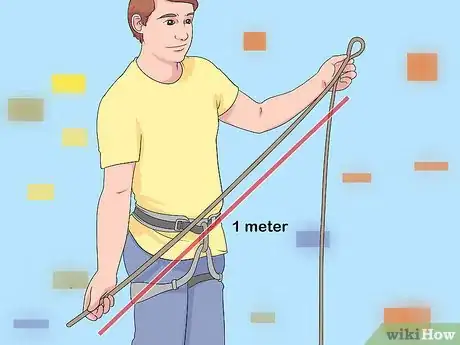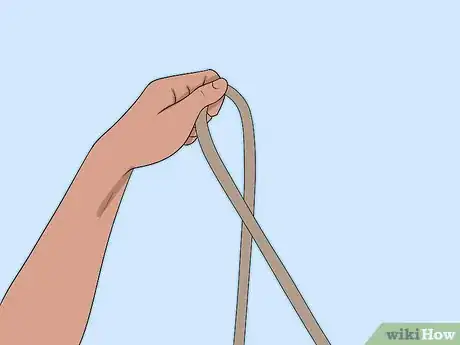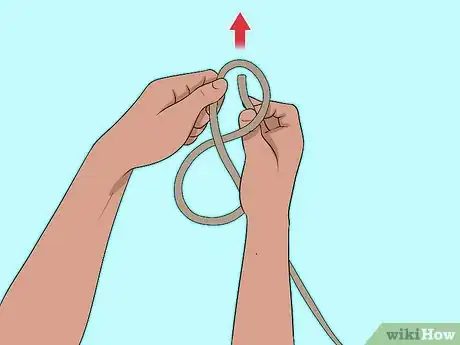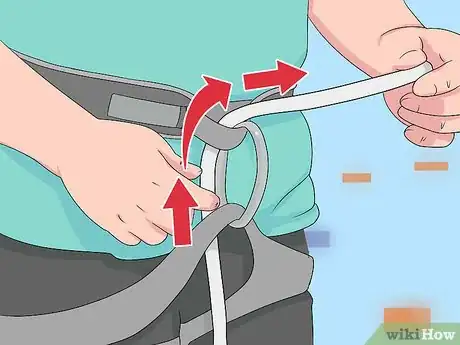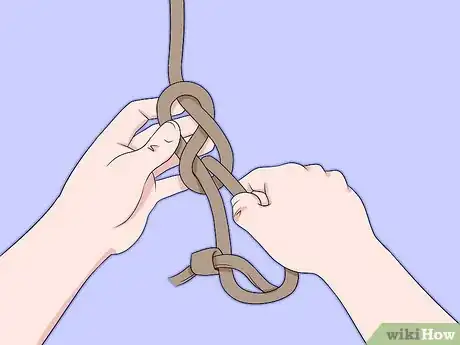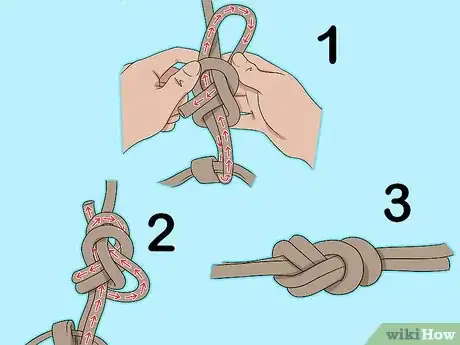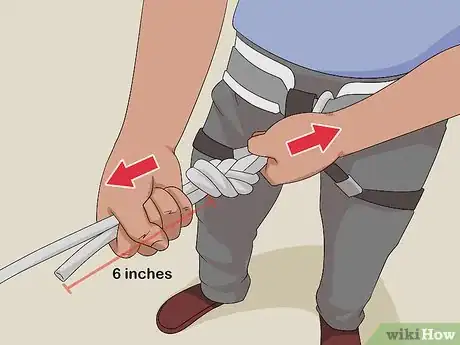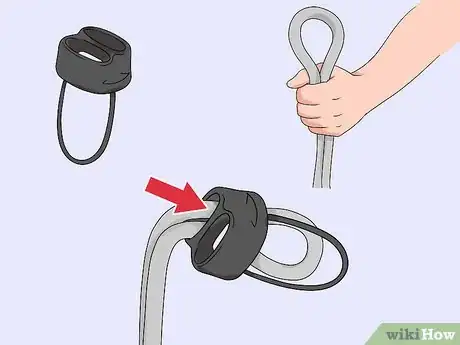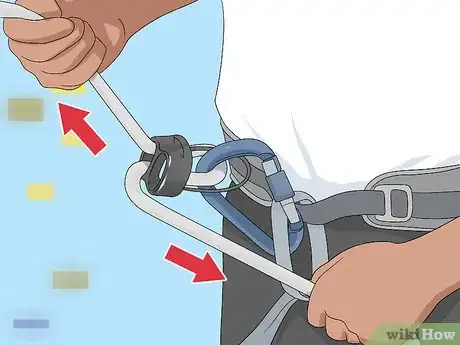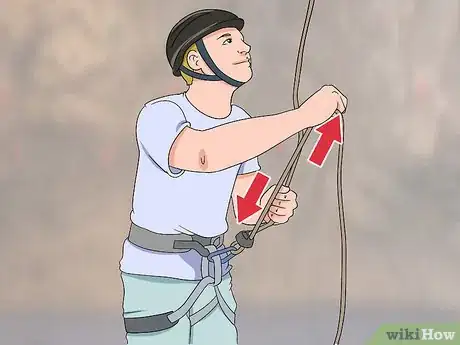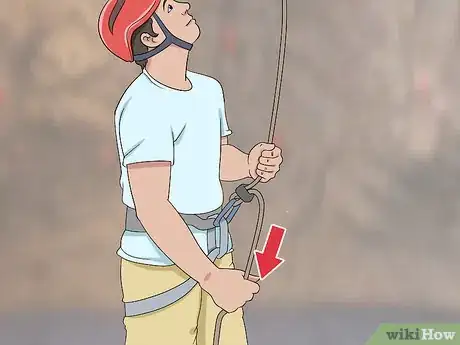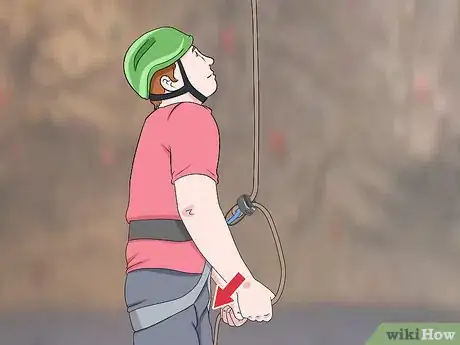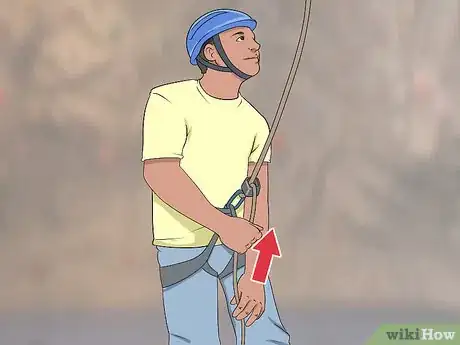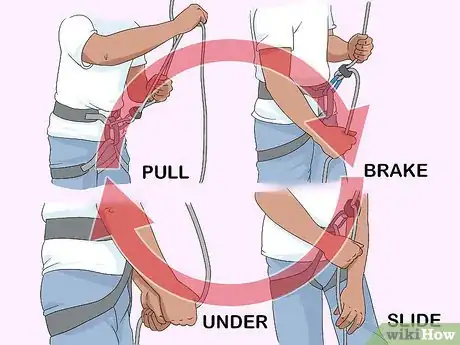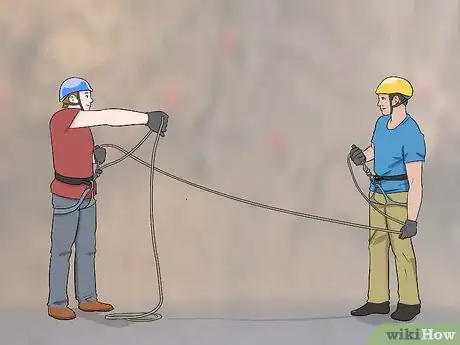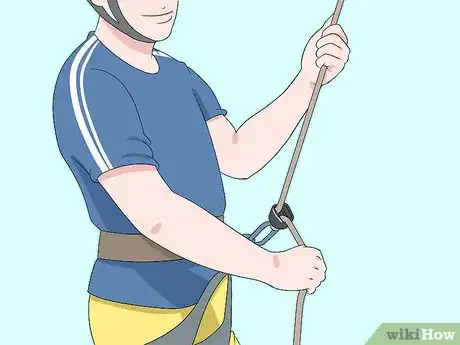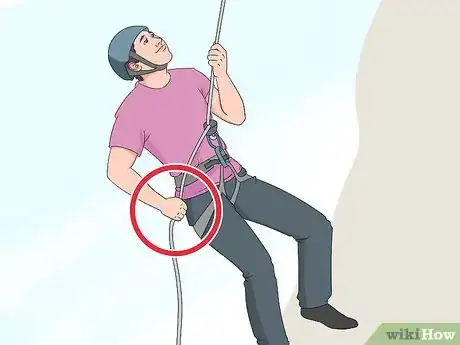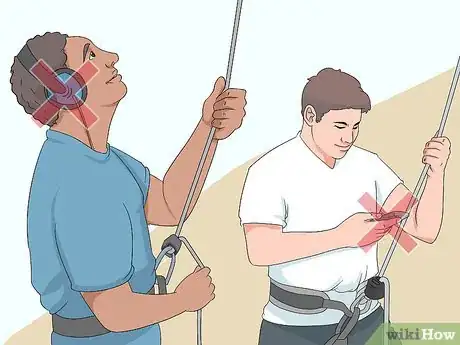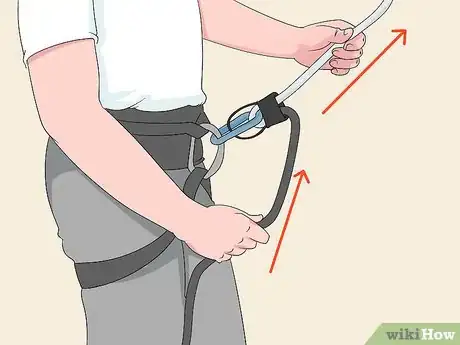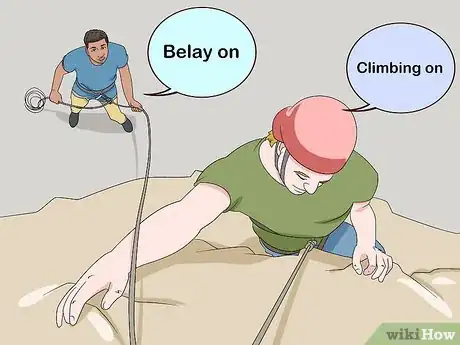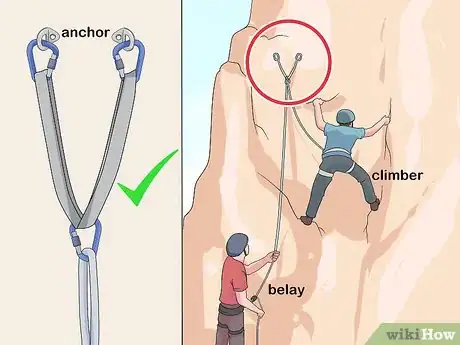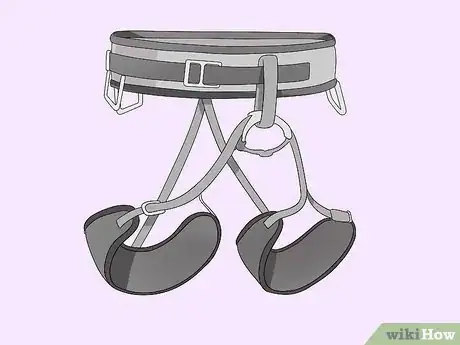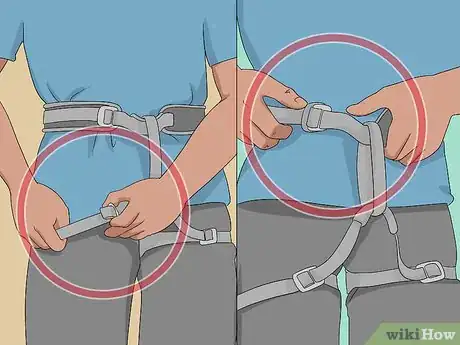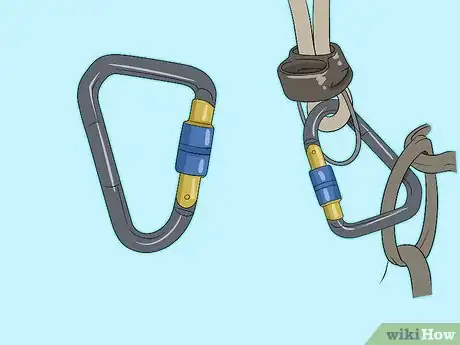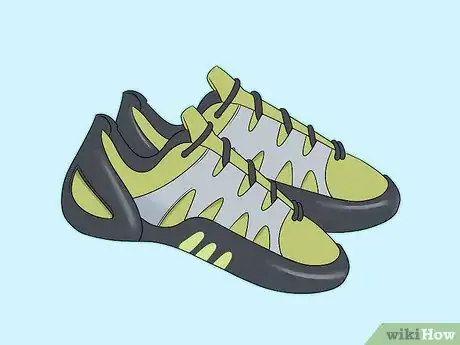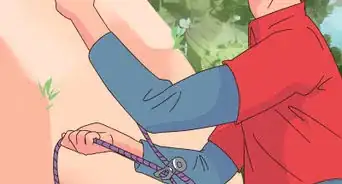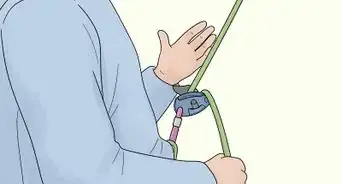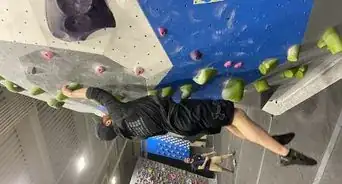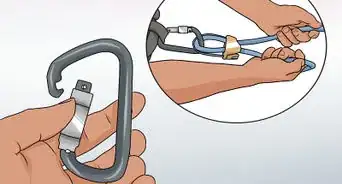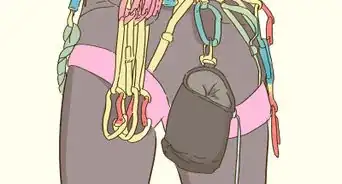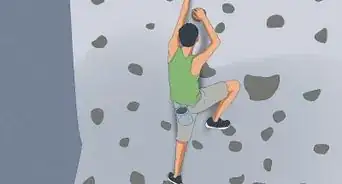This article was co-authored by Erika Noble and by wikiHow staff writer, Megaera Lorenz, PhD. Erika Noble graduated from Stanford University with a BS in Management Science & Engineering. After competing in collegiate rock climbing competitions as part of the Stanford Rock Climbing team, Erika worked as a Rock Climbing Instructor in Lake Tahoe. She continues to boulder and climb throughout California and the Southwest.
There are 7 references cited in this article, which can be found at the bottom of the page.
This article has been viewed 29,017 times.
Belaying is a climbing technique in which a climber ascends while wearing a harness attached to a climbing rope. A climbing partner – called the belayer – stands below, controlling the tension on the climbing rope and helping the climber stay secure and avoid dangerous falls. In order to belay safely, learn how to tie in correctly and practice the PBUS (Pull, Brake, Under, Slide) system. Use good belaying techniques and proper safety equipment.
Steps
Tying in with a Figure 8 Follow Through Knot
-
1Make a loop in one end of the climbing rope. Most professional climbers recommend tying in the climber with a Figure 8 Follow Through knot.[1] Start by making a loop, or bight, about three feet (one meter) from the end of the rope. This can be measured with one arm length.
-
2Bend the tail around the rope below the loop. While holding the loop you have just made, pass the tail of the rope around the front of the main strand a little bit below the bottom of the loop. You should now have a shape like an ampersand (&).[2]Advertisement
-
3Pull the tail back through the top loop. Pass the tail end of the rope through your original loop from behind. This will create a loose figure 8 knot. Do not tighten the knot.[3]
-
4Pull the tail of the rope through the hard-points in the climber’s harness. Start the process of connecting the figure 8 knot to the climber’s harness. Pick up the end of the rope where you just made the figure 8, and run the tail of the rope through the hard-points or loops on the front of the climber’s harness. Pull until the knot is 2-3 inches (5-8 cm) from the harness.[4]
-
5Start the “Follow Through.” Once the tail is fed through both tie-in loops, grab the end of the tail and start to feed it back into the figure 8 knot. Start at the same point where the tail emerges from the knot.[5]
-
6Trace the path of the original figure 8. Carefully feed the tail through the knot, following the strands of the original figure 8, until you have a figure 8 knot that is two strands thick. Take care to keep the strand of the “follow through” parallel to the strand of the original knot.[6]
-
7Dress the knot. Check to make sure all the strands of rope are lined up correctly, and pull the knot tight. Tighten by pulling each of the four strands emerging from the knot. You should have at least six inches (15 cm) of excess tail left over when you are done. Have your partner or instructor double-check the knot to make sure it is properly tied and secure.[7]
- If you do not have enough tail left over, untie the knot and retie it further from the end of the rope.
-
8Feed a bite of rope through one of the slots in the belay device. Once the climber is tied in, the belayer must set up their belay device. The most common type of belay device is an ACT, which features two slots for feeding through a bite of rope, and a wire keeper. Make a small bite (not a twist or full loop) in the opposite end of the rope from the one that is attached to the climber’s harness. Make sure the top of the rope bite emerges on the same side as the wire keeper.[8]
-
9Attach the rope and belay device to your harness. Hook a locking carabiner through both the rope and the wire keeper, and attach it to the belay loop on your harness. Lock the carabiner securely.[9]
- If you have a horizontally oriented belay loop, make sure the rope is oriented so that the tail end is in your dominant hand.
- The tail end of the rope is the “brake strand,” which is the part of the rope that you will need to control in order to arrest falls and manipulate the amount of tension in the climbing rope.[10] .
EXPERT TIPErika Noble graduated from Stanford University with a BS in Management Science & Engineering. After competing in collegiate rock climbing competitions as part of the Stanford Rock Climbing team, Erika worked as a Rock Climbing Instructor in Lake Tahoe. She continues to boulder and climb throughout California and the Southwest.PCIA Certified Rock Climbing Instructor
 Erika Noble
Erika Noble
PCIA Certified Rock Climbing InstructorErika Noble, Rock Climbing Instructor, advises: “Always double-check to make sure your carabiner is correctly locked. It's an essential part of the safety checks that should be done each time before you climb and can often be overlooked.”
Learning the PBUS System
-
1Sign up for a PBUS belay class. It is important to get professional instruction before you begin to belay. Most gyms that have indoor climbing walls offer belaying instructions, and may require you to get a certification or pass a test before you can use their equipment on your own. Most belay classes will teach you the PBUS (Pull, Brake, Under, Slide) method.[11]
- PBUS is a basic belaying technique that allows you to safely and steadily control the slack in the rope as your partner ascends.
- The PBUS technique involves using short, controlled, repetitive movements.
-
2Practice the pull. The first part of the PBUS method is the “Pull.” As the climber moves up, slowly pull down on the guide strand of your rope to take in the slack. The guide strand is the part of the rope that attaches to the climber. At the same time, pull up on the brake strand (the tail end of the rope) in order to feed the excess rope through the belay device.[12]
-
3Put your rope in brake position. The B in PBUS stands for “Brake.” Once you’ve removed enough slack from the climber’s rope, pull down on the brake strand to hold the rope in place. Braking is one of the most important parts of belaying, since you will need to be able to brake quickly in case of falls. Make sure you always have at least one hand on the brake strand at all times.[13]
-
4Put your guide hand under your brake hand. This is the “Under” part of the PBUS technique. Holding the brake strand in brake position, remove your hand from the guide strand and place it underneath your brake hand on the brake strand. This motion begins the process of repositioning your hands so that you have full control of the brake strand after a pull and brake.[14]
-
5Slide your brake hand back up the brake line. The S in PBUS is for “Slide.” During the pull and brake parts of the PBUS maneuver, your brake hand will move away from the belay device, and will need to be moved back into place. Once you’ve put your guide hand under the brake hand, slide your brake hand up the brake line until it is about 3 inches (8 cm) from the belay device. Put your other hand back on the guide strand.[15]
-
6Repeat this process as the climber continues to ascend. Once the climber is ready to move again, repeat the whole process, starting with the pull. Practice going through the PBUS motions until they become natural and automatic.[16]
-
7Practice without tying in. Before you try an actual climb, you and your partner can practice without tying in the climber. Instead, have the climber pull or release the rope to simulate the changes in tension you would experience during a real climb, and practice reacting appropriately.
Using Proper Belaying Techniques
-
1Keep your hands on the rope at all times. While belaying, you must keep your dominant hand on the brake strand (the “tail” end of the rope emerging from the belay device) at all times. Your other hand should be either on the guide strand (the part of the rope that leads up to the climber) or on the brake strand, depending where you are in the belaying process. Keeping both hands in place will allow you to maintain control of the rope and quickly pull it taut in case of a fall.[17]
-
2Brake if the climber falls or needs to stop. Being able to do a strong brake is vital to safe belaying. If the climber starts to fall, reaches the top of the climb, or needs a moment to rest, pull the brake strand straight down while holding it directly in front of your body.[18]
- For an extra stable brake, use both hands.
- You can also add some extra tension by using your body weight in addition to your brake hand. Keeping your brake hand in place, use your other hand to wrap the brake strand around your hip and just under your butt.
-
3Pay attention to the climber at all times. Whichever climbing technique you use, it is crucial that the belayer stays vigilant and keeps a close eye (and ear) on the climber. Do not listen to music, check your phone, or allow yourself to become distracted by the scenery or other climbers.[19]
-
4Feed the brake line back through the belay device to create slack. If the climber needs extra slack, or is ready to start descending, use carefully controlled movements increase the slack. Put both hands on the brake strand, and use the top hand to slowly feed rope back up through the belay device. If the climber starts to descend too quickly or if there is too much slack, immediately pull the brake strand down in front of you to put it back in brake position.[20]
-
5Communicate with the climber using calls. Being able to communicate with your climbing partner is vitally important during belaying. Before you begin a climb, work out a system and make sure that you both understand what the different calls mean. There are a variety of standard communication systems, but the most important thing is to pick a system that works for both you and your partner. Examples of common calls include:[21]
- “Ready to climb,” or “On belay?” when the climber is checking in with the belayer before starting to climb. The belayer may respond with “On belay,” or “Belay on.”
- “Climb ready,” or “Climbing,” when the climber begins to climb. The belayer may respond with “Climb,” or “Climb on.”
- Other climbing calls include “Slack” (when the climber needs more slack), “Up rope” or “Take” (when the climber needs less slack), “That’s me” (once enough excess slack has been taken in), “Falling!” (if the climber is falling or beginning to fall), and “Safe” or “Belay off” for once the climber has reached their destination at the top of the climb safely.
-
6Try a top-rope setup for greater stability. Top-rope climbing, or top-roping, is a method in which the rope is attached to a pre-set anchor at the top of the climb. Top-roping offers greater stability and a lower risk of serious falls than lead climbing. The anchor at the top of the climb will help keep the rope taut with less effort required from the belayer. Top-roping is the best technique to use when you are learning how to belay.[22]
Setting up Your Equipment
-
1Get rock climbing harnesses with belay loops. The climber and belayer must both wear harnesses designed and tested for rock climbing. Make sure the harness has a waist belt, tie-in point, belay loop, and buckles.[23]
- Some harnesses use the same point for tie-in and the belay loop.
- You can purchase climbing gear at most stores that sell outdoor recreational equipment. You may be able to rent harnesses and other equipment for indoor climbing at your gym.
- Many universities that offer outdoor recreational programs will allow students, faculty, staff, or alumni to rent climbing equipment.
-
2Put the harness on correctly. Step into the harness as you would a pair of pants. Your legs go through the leg loops, with the pair of elastic straps (called risers) that attach the loops to the belt facing the back. Pull the waist belt up over your hips, with the tie-in point and belay loop facing the front. Use the buckles on the waist band and leg loops to adjust the harness so that it fits comfortably.
-
3Use a safe locking carabiner with your belay device. Purchase a locking carabiner that is designed for use as climbing gear. Since the carabiner is the only thing keeping the rope and belay device attached to your harness, it will need to be strong and sturdy. Climbing carabiners are available at stores that sell outdoor recreation equipment.
-
4Get good climbing shoes. Climbing shoes are designed to be flexible and to have excellent grip. A good climbing shoe should have soft, sticky rubber soles that offer plenty of friction.[24]
- You can purchase climbing shoes from outdoor recreation or sporting goods stores. You may also be able to rent climbing shoes at your gym.
- If you choose to rent climbing shoes, make sure the soles are in good condition.
-
5Use climbing chalk. Chalk is useful for reducing moisture on your palms and enhancing your grip, whether you’re climbing or controlling the rope. You can purchase climbing chalk at sporting goods or outdoor recreation stores.[25]
- Note that some gyms do not allow chalk or have restrictions on what kind of climbing chalk you can use.
- Your gym may provide climbing chalk. Call ahead to find out whether you need to bring your own.
Warnings
- Have a certified instructor show you how to set up your equipment and use basic belaying techniques before trying it on your own. Reading about belaying or watching a video are not substitutes for professional instruction.⧼thumbs_response⧽
References
- ↑ https://www.climbing.com/skills/learn-to-climb-tie-in-with-a-figure-eight-follow-through-knot/
- ↑ https://www.climbing.com/skills/learn-to-climb-tie-in-with-a-figure-eight-follow-through-knot/
- ↑ https://www.climbing.com/skills/learn-to-climb-tie-in-with-a-figure-eight-follow-through-knot/
- ↑ https://www.climbing.com/skills/learn-to-climb-tie-in-with-a-figure-eight-follow-through-knot/
- ↑ https://www.climbing.com/skills/learn-to-climb-tie-in-with-a-figure-eight-follow-through-knot/
- ↑ https://www.climbing.com/skills/learn-to-climb-tie-in-with-a-figure-eight-follow-through-knot/
- ↑ https://www.climbing.com/skills/learn-to-climb-tie-in-with-a-figure-eight-follow-through-knot/
- ↑ https://americanalpineclub.org/education-blog/2016/3/15/9ifwyakbvdf826by6gv97y1uzk1mzb
- ↑ https://americanalpineclub.org/education-blog/2016/3/15/9ifwyakbvdf826by6gv97y1uzk1mzb
- ↑ https://www.climbing.com/skills/learn-to-climb-better-toprope-belaying/
- ↑ https://www.climbing.com/skills/learn-to-climb-better-toprope-belaying/
- ↑ https://www.climbing.com/skills/learn-to-climb-better-toprope-belaying/
- ↑ https://www.climbing.com/skills/learn-to-climb-better-toprope-belaying/
- ↑ https://www.climbing.com/skills/learn-to-climb-better-toprope-belaying/
- ↑ https://www.climbing.com/skills/learn-to-climb-better-toprope-belaying/
- ↑ https://www.climbing.com/skills/learn-to-climb-better-toprope-belaying/
- ↑ https://www.climbing.com/skills/learn-to-climb-better-toprope-belaying/
- ↑ https://www.climbing.com/skills/learn-to-climb-better-toprope-belaying/
- ↑ https://www.climbing.com/skills/learn-to-climb-better-toprope-belaying/
- ↑ https://www.climbing.com/skills/learn-to-climb-better-toprope-belaying/
- ↑ https://www.princeton.edu/~oa/climb/belaywal.shtml
- ↑ http://blog.weighmyrack.com/top-roping-vs-lead-climbing/
- ↑ https://americanalpineclub.org/education-blog/2016/3/15/9ifwyakbvdf826by6gv97y1uzk1mzb
- ↑ https://www.climbing.com/gear/the-science-of-climbing-shoe-sticky-rubber/
- ↑ https://www.theadventurejunkies.com/best-climbing-chalk/
- ↑ http://blog.weighmyrack.com/top-roping-vs-lead-climbing/
About This Article
To belay, start by putting on the harness like a pair of pants, with the belay loop facing the front. Then, attach the climbing ropes using a sturdy carabiner. Make sure to keep your hands on the rope at all times so you can quickly pull it taut in case of a fall. If you need to break, pull the break strand straight down in front of you. Additionally, communicate with the climber using calls like "Climb on" to tell them to start climbing, or "That's me" to indicate they've has reached their final destination. For tips on how to attach your belaying gear with a figure eight follow through knot, read on!
